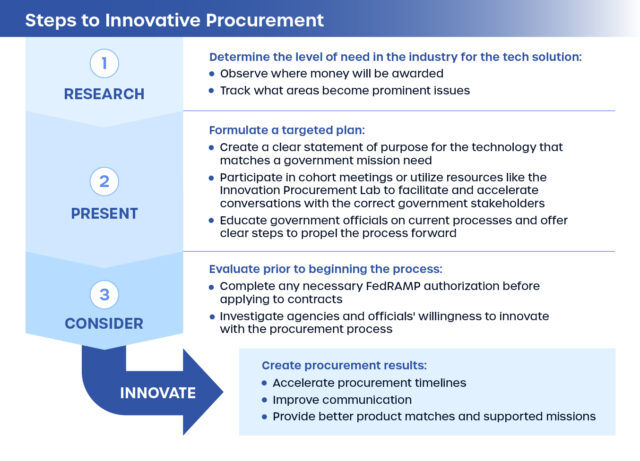As technology changes, innovation is necessary to update systems in a timely manner so the government can keep pace with the greater technological environment. To accomplish this and improve the defense of the nation, private sector solutions need to be sold to federal agencies swiftly and effectively. Currently, the commercial industry moves substantially faster than the government due to the federal procurement process time.
Procurement, which is the method of acquiring products to improve or complete an agency’s mission, should be combined with innovation to provide efficient service and optimized technology delivery to the public sector. Through communication and collaboration, the federal government and the private sector can take advantage of resources to spur innovation and time to deployment.
Accelerating Government Procurement
 Government procurement can be lengthy, as it involves handling prime contractors, working through the budgeting process and navigating rapid technology and resource changes. In light of this, many tech companies are unsure of how to deal with the government.
Government procurement can be lengthy, as it involves handling prime contractors, working through the budgeting process and navigating rapid technology and resource changes. In light of this, many tech companies are unsure of how to deal with the government.
Having recognized this hesitancy, the Department of Defense (DoD) has worked collaboratively to make their contracts more attractive and easier to access. As a result, 75% of tech companies that the Air Force conducts business with now had never previously contracted with the DoD before. Innovation and collaboration can minimize procurement delays and clearly enhance private and public sector cooperation.
Innovation 1: Understanding Procurement Resources & Communicating Early
One crucial element to driving process improvement and increased understanding, is for the public and private sector to discuss the market needs, tech solutions, and contract availability before the acquisition stage. While these conversations are currently underutilized and often viewed with apprehension, they fall safely within the ethics code and can have a major impact on the overall success of a contract. Through these conversations, both industry and government parties can ensure alignment between obtainment strategies and mission goals.
For example, an acquisition innovation lab assists with innovative acquisition techniques and develops best practices, providing tech companies with a safe space to engage with government procurement officials. By researching and understanding the current needs, budget allocations and available resources, tech companies can offer government procurement officers a simple path forward. Since government employees have limited time to sort through the various new resources, presenting all the elements and coming to the table with a clear understanding expedites the process. Working with system integrators also helps government employees acquire the necessary products for their missions.
The Small Business Innovation Research (SBIR) and Small Business Technology Transfer (STTR) programs support small business in reaching commercialization within Federal Research and Research and Development (R&D). As an awards-based program, SBIR and STTR incentivize the development and procurement process to stimulate tech innovations. These programs provide an avenue for companies to bring their products to a public sector market and connect with government needs. By qualifying for an SBIR or STTR award, companies meet the competition requirement and have a sole source award providing an easier path to acquiring contracts.
Innovation 2: Presenting Proactively
Tech companies have the ability to proactively contact government market research teams to discuss their tech capabilities and how they match a mission need. Through an intentional targeting approach, the private sector can reach its desired audience much faster than contacting mass groups of government stakeholders to whom the specific technology might not be relevant.
Contacting the correct stakeholder based on an understanding of their problem and a providing a clear presentation of how the technology will solve that issue, removes significant wait times and deliberation. Tech companies can seek out cohorts who will walk them through best practices and how to engage with the government correctly. Procurement professionals, such as those at the Procurement Innovation Lab, are a major storehouse of information and can also advise companies on how to target program offices.
To help government agencies appreciate the value of emerging technologies, private sector companies should promote how their tech products solve the agency’s specific mission needs. To have a convincing presentation, technology companies must recognize what makes their product unique, and market it based on what gives it a competitive advantage within the industry.
Innovation 3: Implementing Preliminary Steps Before Starting the Process
The government has also instituted additional requirements for solutions that are deployed within their environments. Providers must assure compliance with these supply chain security, cyber hygiene, cyber security, maturity modeling and Federal Risk and Authorization Management Program (FedRAMP) mandates, among others. For example, being FedRAMP-authorized is a baseline requirement that opens many procurement doors for companies that run Software as a Service (SaaS) in a cloud-based environment. Each tech company should research FedRAMP requirements to determine if they need authorization to sell to the government and then weigh the opportunity against the cost of going through the certification process. Tech companies that proceed with obtaining the authorization should view the FedRAMP process as a marketing cost, because without the authorization, the procurement conversation may never be initiated. Having the authorization in hand before approaching bidding, allows tech companies, especially those selling SaaS, a better opportunity to be considered and not immediately disqualified. Procurement experts also recommend that tech companies selling software contemplate preemptively obtaining an Authority to Operate (ATO), which is an additional security authorization that would further aid with a smooth procurement process.
Tech companies must evaluate where to invest their time and resources before completely engaging to maximize progress and efficiency, which also includes focusing on agencies and procurement officials who are ready to innovate in their procurement. These preliminary steps can save hours of frustration and prevent the private sector from chasing dead-end opportunities.

Delivering With Purpose
When tech companies engage in conversation, collaboration, proactive research and targeted marketing, they can effectively reduce the processing time for acquiring and deploying commercial products in the federal market. Tech companies must leverage their market intelligence to help government agencies understand the resources available to them to enable more innovative procurement. In doing so, both the public and private sector can benefit from the improved procurement process which supports tech modernization and enables critical missions.
To learn more about how to get involved in the Government procurement process and hearing innovative ideas from a panel of thought leaders, watch the webinar here.






